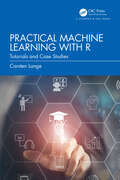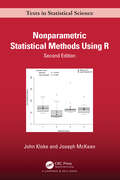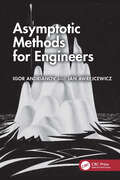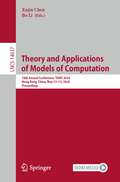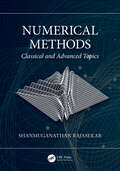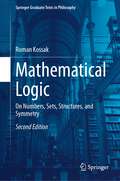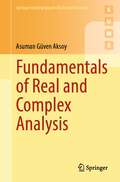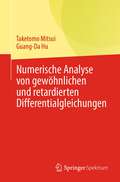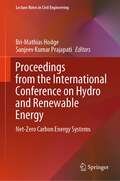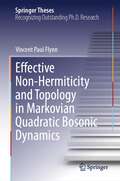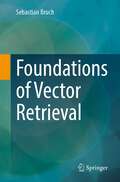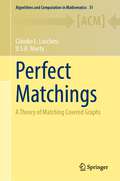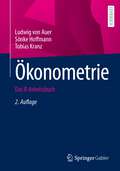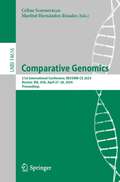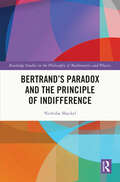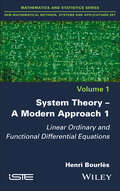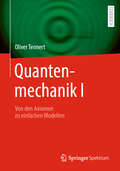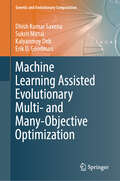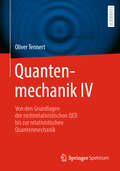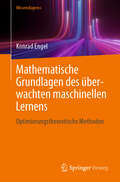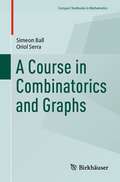- Table View
- List View
Practical Machine Learning with R: Tutorials and Case Studies
by Carsten LangeThis textbook is a comprehensive guide to machine learning and artificial intelligence tailored for students in business and economics. It takes a hands-on approach to teach machine learning, emphasizing practical applications over complex mathematical concepts. Students are not required to have advanced mathematics knowledge such as matrix algebra or calculus.The author introduces machine learning algorithms, utilizing the widely used R language for statistical analysis. Each chapter includes examples, case studies, and interactive tutorials to enhance understanding. No prior programming knowledge is needed. The book leverages the tidymodels package, an extension of R, to streamline data processing and model workflows. This package simplifies commands, making the logic of algorithms more accessible by minimizing programming syntax hurdles. The use of tidymodels ensures a unified experience across various machine learning models.With interactive tutorials that students can download and follow along at their own pace, the book provides a practical approach to apply machine learning algorithms to real-world scenarios.In addition to the interactive tutorials, each chapter includes a Digital Resources section, offering links to articles, videos, data, and sample R code scripts. A companion website further enriches the learning and teaching experience: https://ai.lange-analytics.com.This book is not just a textbook; it is a dynamic learning experience that empowers students and instructors alike with a practical and accessible approach to machine learning in business and economics. Key Features: Unlocks machine learning basics without advanced mathematics — no calculus or matrix algebra required. Demonstrates each concept with R code and real-world data for a deep understanding — no prior programming knowledge is needed. Bridges the gap between theory and real-world applications with hands-on interactive projects and tutorials in every chapter, guided with hints and solutions. Encourages continuous learning with chapter-specific online resources—video tutorials, R-scripts, blog posts, and an online community. Supports instructors through a companion website that includes customizable materials such as slides and syllabi to fit their specific course needs.
Nonparametric Statistical Methods Using R (Chapman & Hall/CRC Texts in Statistical Science)
by John Kloke Joseph McKeanPraise for the first edition:“This book would be especially good for the shelf of anyone who already knows nonparametrics, but wants a reference for how to apply those techniques in R.”-The American StatisticianThis thoroughly updated and expanded second edition of Nonparametric Statistical Methods Using R covers traditional nonparametric methods and rank-based analyses. Two new chapters covering multivariate analyses and big data have been added. Core classical nonparametrics chapters on one- and two-sample problems have been expanded to include discussions on ties as well as power and sample size determination. Common machine learning topics --- including k-nearest neighbors and trees --- have also been included in this new edition.Key Features: Covers a wide range of models including location, linear regression, ANOVA-type, mixed models for cluster correlated data, nonlinear, and GEE-type. Includes robust methods for linear model analyses, big data, time-to-event analyses, timeseries, and multivariate. Numerous examples illustrate the methods and their computation. R packages are available for computation and datasets. Contains two completely new chapters on big data and multivariate analysis. The book is suitable for advanced undergraduate and graduate students in statistics and data science, and students of other majors with a solid background in statistical methods including regression and ANOVA. It will also be of use to researchers working with nonparametric and rank-based methods in practice.
Nonparametric Statistical Methods Using R (Chapman & Hall/CRC Texts in Statistical Science)
by John Kloke Joseph McKeanPraise for the first edition:“This book would be especially good for the shelf of anyone who already knows nonparametrics, but wants a reference for how to apply those techniques in R.”-The American StatisticianThis thoroughly updated and expanded second edition of Nonparametric Statistical Methods Using R covers traditional nonparametric methods and rank-based analyses. Two new chapters covering multivariate analyses and big data have been added. Core classical nonparametrics chapters on one- and two-sample problems have been expanded to include discussions on ties as well as power and sample size determination. Common machine learning topics --- including k-nearest neighbors and trees --- have also been included in this new edition.Key Features: Covers a wide range of models including location, linear regression, ANOVA-type, mixed models for cluster correlated data, nonlinear, and GEE-type. Includes robust methods for linear model analyses, big data, time-to-event analyses, timeseries, and multivariate. Numerous examples illustrate the methods and their computation. R packages are available for computation and datasets. Contains two completely new chapters on big data and multivariate analysis. The book is suitable for advanced undergraduate and graduate students in statistics and data science, and students of other majors with a solid background in statistical methods including regression and ANOVA. It will also be of use to researchers working with nonparametric and rank-based methods in practice.
Asymptotic Methods for Engineers
by Igor V. Andrianov Jan AwrejcewiczAsymptotic Methods for Engineers is based on the authors’ many years of practical experience in the application of asymptotic methods to solve engineering problems.This book is devoted to modern asymptotic methods (AM), which is widely used in engineering, applied sciences, physics, and applied mathematics. Avoiding complex formal calculations and justifications, the book’s main goal is to describe the main ideas and algorithms. Moreover, not only is there a presentation of the main AM, but there is also a focus on demonstrating their unity and inseparable connection with the methods of summation and asymptotic interpolation.The book will be useful for students and researchers from applied mathematics and physics and of interest to doctoral and graduate students, university and industry professors from various branches of engineering (mechanical, civil, electro-mechanical, etc.).
Asymptotic Methods for Engineers
by Igor V. Andrianov Jan AwrejcewiczAsymptotic Methods for Engineers is based on the authors’ many years of practical experience in the application of asymptotic methods to solve engineering problems.This book is devoted to modern asymptotic methods (AM), which is widely used in engineering, applied sciences, physics, and applied mathematics. Avoiding complex formal calculations and justifications, the book’s main goal is to describe the main ideas and algorithms. Moreover, not only is there a presentation of the main AM, but there is also a focus on demonstrating their unity and inseparable connection with the methods of summation and asymptotic interpolation.The book will be useful for students and researchers from applied mathematics and physics and of interest to doctoral and graduate students, university and industry professors from various branches of engineering (mechanical, civil, electro-mechanical, etc.).
Theory and Applications of Models of Computation: 18th Annual Conference, TAMC 2024, Hong Kong, China, May 13–15, 2024, Proceedings (Lecture Notes in Computer Science #14637)
by Xujin Chen Bo LiThis book constitutes the proceedings of the 18th Annual Conference on Theory and Applications of Models of Computation, TAMC 2024, which was held in Hong Kong, China, during May 13–15, 2024. The 30 full papers presented in this book were carefully reviewed and selected from 69 submissions. The main themes of the selected papers are computability, complexity, algorithms, information theory, as well as their integration with machine learning theory and the foundations of artificial intelligence.
Numerical Methods: Classical and Advanced Topics
by Shanmuganathan RajasekarThis book presents a pedagogical treatment of a wide range of numerical methods to suit the needs of undergraduate and postgraduate students, and teachers and researchers in physics, mathematics, and engineering. For each method, the derivation of the formula/algorithm, error analysis, case studies, applications in science and engineering and the special features are covered. A detailed presentation of solving time-dependent Schrödinger equation and nonlinear wave equations, along with the Monte Carlo techniques (to mention a few) will aid in students’ understanding of several physical phenomena including tunnelling, elastic collision of nonlinear waves, electronic distribution in atoms, and diffusion of neutrons through simulation study.The book covers advanced topics such as symplectic integrators and random number generators for desired distributions and Monte Carlo techniques, which are usually overlooked in other numerical methods textbooks. Interesting updates on classical topics include: curve fitting to a sigmoid and Gaussian functions and product of certain two functions, solving of differential equations in the presence of noise, and solving the time-independent Schrödinger equation.Solutions are presented in the forms of tables and graphs to provide visual aid and encourage a deeper comprehension of the topic. The step-by-step computations presented for most of the problems can be verifiable using a scientific calculator and is therefore appropriate for classroom teaching. The readers of the book will benefit from acquiring an acquittance, knowledge, experience and realization of significance of the numerical methods covered, their applicability to physical and engineering problems and the advantages of applying numerical methods over theoretical methods for specific problems.
Mathematical Logic: On Numbers, Sets, Structures, and Symmetry (Springer Graduate Texts in Philosophy #4)
by Roman KossakThis textbook is a second edition of the successful, Mathematical Logic: On Numbers, Sets, Structures, and Symmetry. It retains the original two parts found in the first edition, while presenting new material in the form of an added third part to the textbook. The textbook offers a slow introduction to mathematical logic, and several basic concepts of model theory, such as first-order definability, types, symmetries, and elementary extensions. Part I, Logic Sets, and Numbers, shows how mathematical logic is used to develop the number structures of classical mathematics. All necessary concepts are introduced exactly as they would be in a course in mathematical logic; but are accompanied by more extensive introductory remarks and examples to motivate formal developments. The second part, Relations, Structures, Geometry, introduces several basic concepts of model theory, such as first-order definability, types, symmetries, and elementary extensions, and shows how they are usedto study and classify mathematical structures. The added Part III to the book is closer to what one finds in standard introductory mathematical textbooks. Definitions, theorems, and proofs that are introduced are still preceded by remarks that motivate the material, but the exposition is more formal, and includes more advanced topics. The focus is on the notion of countable categoricity, which analyzed in detail using examples from the first two parts of the book. This textbook is suitable for graduate students in mathematical logic and set theory and will also be of interest to mathematicians who know the technical aspects of the subject, but are not familiar with its history and philosophical background.
Fundamentals of Real and Complex Analysis (Springer Undergraduate Mathematics Series)
by Asuman Güven AksoyThe primary aim of this text is to help transition undergraduates to study graduate level mathematics. It unites real and complex analysis after developing the basic techniques and aims at a larger readership than that of similar textbooks that have been published, as fewer mathematical requisites are required. The idea is to present analysis as a whole and emphasize the strong connections between various branches of the field. Ample examples and exercises reinforce concepts, and a helpful bibliography guides those wishing to delve deeper into particular topics. Graduate students who are studying for their qualifying exams in analysis will find use in this text, as well as those looking to advance their mathematical studies or who are moving on to explore another quantitative science.Chapter 1 contains many tools for higher mathematics; its content is easily accessible, though not elementary. Chapter 2 focuses on topics in real analysis such as p-adic completion, Banach Contraction Mapping Theorem and its applications, Fourier series, Lebesgue measure and integration. One of this chapter’s unique features is its treatment of functional equations. Chapter 3 covers the essential topics in complex analysis: it begins with a geometric introduction to the complex plane, then covers holomorphic functions, complex power series, conformal mappings, and the Riemann mapping theorem. In conjunction with the Bieberbach conjecture, the power and applications of Cauchy’s theorem through the integral formula and residue theorem are presented.
Numerical Methods: Classical and Advanced Topics
by Shanmuganathan RajasekarThis book presents a pedagogical treatment of a wide range of numerical methods to suit the needs of undergraduate and postgraduate students, and teachers and researchers in physics, mathematics, and engineering. For each method, the derivation of the formula/algorithm, error analysis, case studies, applications in science and engineering and the special features are covered. A detailed presentation of solving time-dependent Schrödinger equation and nonlinear wave equations, along with the Monte Carlo techniques (to mention a few) will aid in students’ understanding of several physical phenomena including tunnelling, elastic collision of nonlinear waves, electronic distribution in atoms, and diffusion of neutrons through simulation study.The book covers advanced topics such as symplectic integrators and random number generators for desired distributions and Monte Carlo techniques, which are usually overlooked in other numerical methods textbooks. Interesting updates on classical topics include: curve fitting to a sigmoid and Gaussian functions and product of certain two functions, solving of differential equations in the presence of noise, and solving the time-independent Schrödinger equation.Solutions are presented in the forms of tables and graphs to provide visual aid and encourage a deeper comprehension of the topic. The step-by-step computations presented for most of the problems can be verifiable using a scientific calculator and is therefore appropriate for classroom teaching. The readers of the book will benefit from acquiring an acquittance, knowledge, experience and realization of significance of the numerical methods covered, their applicability to physical and engineering problems and the advantages of applying numerical methods over theoretical methods for specific problems.
Numerische Analyse von gewöhnlichen und retardierten Differentialgleichungen
by Taketomo Mitsui Guang-Da HuDieses Buch dient als prägnantes Lehrbuch für Studenten in einem fortgeschrittenen Undergraduate- oder First-Year-Graduate-Kurs in verschiedenen Disziplinen wie angewandte Mathematik, Steuerung und Ingenieurwesen, die den modernen Standard der numerischen Methoden von gewöhnlichen und verzögerten Differentialgleichungen verstehen wollen. Experten in denselben Bereichen können sich auch über die jüngsten Entwicklungen in der numerischen Analyse solcher Differentialsysteme informieren. Gewöhnliche Differentialgleichungen (ODEs) sind ein starkes mathematisches Werkzeug, um eine Vielzahl von Phänomenen in Wissenschaft und Technik auszudrücken. Neben ihrer eigenen Bedeutung ist eine der mächtigen Richtungen, in die sich ODEs ausdehnen, die Einbeziehung einer unbekannten Funktion mit verzögertem Argument. Dies wird als verzögerte Differentialgleichungen (Delay differential equations, DDEs) bezeichnet, die häufig in der mathematischen Modellierung vonBiologie, Demographie, Epidemiologie und Kontrolltheorie vorkommen. In einigen Fällen kann die Lösung einer Differentialgleichung durch algebraische Kombinationen bekannter mathematischer Funktionen erhalten werden. In vielen praktischen Fällen ist eine solche Lösung jedoch recht schwierig oder nicht verfügbar, und es sind numerische Näherungen erforderlich. Die moderne Entwicklung von Computern beschleunigt die Situation und eröffnet darüber hinaus mehr Möglichkeiten der numerischen Mittel. Die Kenntnis und das Fachwissen über die numerische Lösung von Differentialgleichungen wird nun in weiten Bereichen der Wissenschaft und des Ingenieurwesens vorausgesetzt.Man könnte meinen, dass ein gut organisiertes Softwarepaket wie MATLAB in etwa die gleiche Lösung bietet. In gewisser Weise stimmt das auch, aber man muss bedenken, dass der blinde Einsatz von Softwarepaketen den Benutzer in die Irre führt. Das Wesentliche der numerischen Lösung von Differentialgleichungen muss noch gelernt werden. Das vorliegende Buch soll das Wesentliche der numerischen Lösungen von gewöhnlichen Differentialgleichungen sowie von Verzögerungsdifferentialgleichungen vermitteln. Die Autoren haben insbesondere festgestellt, dass es noch wenige prägnante Lehrbücher über Verzögerungsdifferentialgleichungen gibt, und haben sich dann daran gemacht, die Lücke durch möglichst transparente Beschreibungen zu schließen. Die wichtigsten Algorithmen zur numerischen Lösung sind in diesem Buch klar beschrieben. Auch die Stabilität von Lösungen von ODEs und DDEs ist von entscheidender Bedeutung. Das Buch führt in die asymptotische Stabilität von analytischen und numerischen Lösungen ein und bietet einen praktischen Weg zur Analyse ihrer Stabilität unter Verwendung einer Theorie komplexer Funktionen.
Proceedings from the International Conference on Hydro and Renewable Energy: Net-Zero Carbon Energy Systems (Lecture Notes in Civil Engineering #391)
by Bri-Mathias Hodge Sanjeev Kumar PrajapatiThis book comprises the select peer-reviewed proceedings of the International Conference on Hydro and Renewable Energy (ICHRE 2022). It aims to provide a comprehensive and broad-spectrum picture of the state-of-the-art research and development in the area of renewable energy technologies, grid integration challenges and opportunities, negative emission technologies, role of distributed energy resources in net zero energy carbon systems, role of hydro energy and pumped storage hydro in power sector decarbonization, policies, and regulations in achieving net zero carbon energy systems, among others. This book provides a valuable resource for those in academia and industry working in the fields of renewable energy, civil engineering, mechanical engineering, among others.
Effective Non-Hermiticity and Topology in Markovian Quadratic Bosonic Dynamics (Springer Theses)
by Vincent Paul FlynnThis thesis provides an in-depth investigation of effective non-Hermiticity and topology in many-mode, non-interacting, bosonic systems. It also establishes the extent to which one must move beyond the Hamiltonian, closed-system setting, in order to uncover signatures of genuine symmetry-protected topological (SPT) physics in "free" (mean-field) bosons. While SPT phases of free fermionic matter and their associated zero-energy boundary-localized modes have been thoroughly explored, similar physics in free bosonic systems still remains elusive. No fermionic counterpart exists for the distinctive dynamical behavior that arises from the effective non-Hermiticity, intrinsic even at equilibrium, to bosonic Hamiltonians. Therefore, a much needed paradigm shift is required to address major conceptual roadblocks in the search for SPT bosonic phases.The analysis within develops, in particular, the notion of topological metastability in quadratic bosonic systems subject to Markovian dissipation. The resulting dynamical paradigm was found to be characterized by both a sharp separation between transient and asymptotic dynamics and non-trivial topological invariants. It also features long-lived boundary-localized "Majorana boson" and "Dirac boson" modes, which realize tight bosonic analogues to the edge modes characteristic of fermionic SPT phases. This comprehensive look into non-interacting bosonic systems breaks important new ground for re-imagining quantum phenomena beyond equilibrium, with novel applications in quantum science.
Foundations of Vector Retrieval
by Sebastian BruchThis book presents the fundamentals of vector retrieval. To this end, it delves into important data structures and algorithms that have been successfully used to solve the vector retrieval problem efficiently and effectively. This monograph is divided into four parts. The first part introduces the problem of vector retrieval and formalizes the concepts involved. The second part delves into retrieval algorithms that help solve the vector retrieval problem efficiently and effectively. It includes a chapter each on brand-and-bound algorithms, locality sensitive hashing, graph algorithms, clustering, and sampling. Part three is devoted to vector compression and comprises chapters on quantization and sketching. Finally, the fourth part presents a review of background material in a series of appendices, summarizing relevant concepts from probability, concentration inequalities, and linear algebra. The book emphasizes the theoretical aspects of algorithms and presents related theorems and proofs. It is thus mainly written for researchers and graduate students in theoretical computer science and database and information systems who want to learn about the theoretical foundations of vector retrieval.
The World of the Abbaco: Abbacus Mathematics Analyzed and Situated Historically Between Fibonacci and Stifel (Frontiers in the History of Science)
by Jens HøyrupThe abbacus was a thorough and complete system of arithmetical calculations, which saw its dawn in the Indian and Arabic tradition of the Middle Ages, but which was developed in its fully fledged aspects especially in Italy, between Genoa, Milan, Venice and the region of Umbria. In this monograph, Høyrup explores how the abbacus tradition has developed in Europe, with a focus on Italy and Germany between the 14th and the 17th Century. With the analysis of texts from Fibonacci, Pacioli, and Stifel to name but a few, this book offers a critical historical analysis of the development and diffusion of a tradition of calculus that has deeply influenced the way in which mathematics has developed in the West. The primary purpose of the book is to present a fairly detailed portrait of the abbacus tradition as it developed historically; as will be argued, Fibonacci was much less important for the emergence of this tradition than mostly assumed – but since his importance isbroadly taken for granted, that argument needs to be made, for which reason Fibonacci’s Liber Abbaci is also described and analyzed in some depth. A secondary purpose is to show how the adoption of abbacus mathematics in German lands gave rise to the creation of a different tradition. The end of the book investigates the interplay of abbacus algebra with other intellectual currents which turned the whole mathematical undertaking upside-down in the 17th Century.
Perfect Matchings: A Theory of Matching Covered Graphs (Algorithms and Computation in Mathematics #31)
by Cláudio L. Lucchesi U.S.R. MurtyBeginning with its origins in the pioneering work of W.T. Tutte in 1947, this monograph systematically traces through some of the impressive developments in matching theory. A graph is matchable if it has a perfect matching. A matching covered graph is a connected graph on at least two vertices in which each edge is covered by some perfect matching. The theory of matching covered graphs, though of relatively recent vintage, has an array of interesting results with elegant proofs, several surprising applications and challenging unsolved problems. The aim of this book is to present the material in a well-organized manner with plenty of examples and illustrations so as to make it accessible to undergraduates, and also to unify the existing theory and point out new avenues to explore so as to make it attractive to graduate students.
Ökonometrie: Das R-Arbeitsbuch
by Ludwig von Auer Sönke Hoffmann Tobias KranzDieses R-Arbeitsbuch bietet seinen Leserinnen und Lesern ökonometrische Übungsaufgaben, die eigenständig am Computer bearbeitet werden können. Die notwendigen Kenntnisse des kostenlosen Programmpakets R werden in „R-Boxen“ quasi nebenbei Schritt für Schritt vermittelt. Den Auftakt bildet dabei eine einfache Installationsanleitung. Auch alle Lösungen der Übungsaufgaben sind sorgfältig dokumentiert.Das R-Arbeitsbuch lässt sich zwar mit jedem einführenden Ökonometrie-Lehrbuch kombinieren, die optimale Verzahnung besteht jedoch mit dem Lehrbuch Ökonometrie - Eine Einführung (von Auer, 8. Auflage, 2023). Die Zielgruppe dieser Lehrbuch-Arbeitsbuch-Kombination besitzt weder statistische oder ökonometrische Kenntnisse noch Erfahrung in der Anwendung statistischer Programme. Für die 2. Auflage wurde das R-Arbeitsbuch gründlich überarbeitet und um zusätzliche Aufgaben ergänzt.
Comparative Genomics: 21st International Conference, RECOMB-CG 2024, Boston, MA, USA, April 27–28, 2024, Proceedings (Lecture Notes in Computer Science #14616)
by Celine Scornavacca Maribel Hernández-RosalesThis book constitutes the proceedings of the 21st International Conference on Comparative Genomics, RECOMB-CG 2024, which was held in Boston, MA, USA, during April 27–28, 2024. The 13 full papers presented in this book were carefully reviewed and selected from 21 submissions. The papers are divided into the following topical sections: phylogenetic networks; homology and phylogenetic reconstruction; tools for evolution reconstruction; genome rearrangements; and genome evolution.
Bertrand’s Paradox and the Principle of Indifference (Routledge Studies in the Philosophy of Mathematics and Physics)
by Nicholas ShackelEvents between which we have no epistemic reason to discriminate have equal epistemic probabilities. Bertrand’s chord paradox, however, appears to show this to be false, and thereby poses a general threat to probabilities for continuum sized state spaces. Articulating the nature of such spaces involves some deep mathematics and that is perhaps why the recent literature on Bertrand’s Paradox has been almost entirely from mathematicians and physicists, who have often deployed elegant mathematics of considerable sophistication. At the same time, the philosophy of probability has been left out. In particular, left out entirely are the philosophical ground of the principle of indifference, the nature of the principle itself, the stringent constraint this places on the mathematical representation of the principle needed for its application to continuum sized event spaces, and what these entail for rigour in developing the paradox itself. This book puts the philosophy and its entailments back in and in so doing casts a new light on the paradox, giving original analyses of the paradox, its possible solutions, the source of the paradox, the philosophical errors we make in attempting to solve it and what the paradox proves for the philosophy of probability. The book finishes with the author’s proposed solution—a solution in the spirit of Bertrand’s, indeed—in which an epistemic principle more general than the principle of indifference offers a principled restriction of the domain of the principle of indifference.Bertrand's Paradox and the Principle of Indifference will appeal to scholars and advanced students working in the philosophy of mathematics, epistemology, philosophy of science, probability theory and mathematical physics.
System Theory -- A Modern Approach, Volume 1: Linear Ordinary and Functional Differential Equations
by Henri BourlèsThe theory of dynamic systems is addressed in this book in accordance with the “modern” approach, heir to algebraic analysis, which has been implemented since the last decade of the 20th century. After a reminder of the evolution of the representation of systems based on transfer functions or matrices, the duality of controllability and observability is revisited, and new results are produced concerning time-varying discrete-time systems. To complete and improve the existing analyses, the poles and zeros of linear systems and their interconnections are presented in a new way, as well as the problem of systems governed by functional differential equations (of retarded or neutral type) and their stabilization. This book also proposes known and original mathematical complements.
Quantenmechanik I: Von den Axiomen zu einfachen Modellen
by Oliver TennertIn einer umfassenden Darstellung entwickeln und vertiefen die vier Bände dieses Lehrbuchs das Gebäude der nichtrelativistischen Quantenmechanik, weshalb sie auch bestens als Nachschlagewerk geeignet sind. Der erste Band beginnt mit einer anekdotenreichen und spannenden historischen Überblicksdarstellung, die die Hauptprotagonisten der Quantentheorie und wichtige Meilensteine ihres Wirkens vorstellt. Im Folgenden wird dann die Formulierung im Hilbert-Raum axiomatisch entwickelt und wichtige Grundlagenthemen behandelt: die eindimensionalen Probleme, der harmonische Oszillator und die WKB-Näherung als Bindeglied zur klassischen Physik. Besonderheiten: Auch komplizierte Zusammenhänge werden illustrativ und klar erklärt. Zahlreiche mathematische Einschübe erläutern allgemeine mathematische Zusammenhänge. Besondere Highlights des Buches sind die frühe Entwicklung von Propagatormethoden, die ausführliche mathematische Behandlung von kohärenten und gequetschten Zuständen des harmonischen Oszillators, sowie die gründliche Untersuchung des klassischen Grenzfalls. Inhalt 1. Historischer Abriss: Der Weg zur Quantenmechanik - 2. Der theoretische Formalismus der Quantenmechanik - 3. Eindimensionale Probleme - 4. Der harmonische Oszillator in der Quantenmechanik - 5. Die WKB-Näherung und der klassische Grenzfall Zielgruppe: Das Buch richtet sich sowohl an Bachelor- als auch an Masterstudierende sowie ihre Lehrenden. Aufgrund seines mehrbändigen Charakters, der breiten Themenvielfalt und Bezügen zu wissenschaftlichen Originalarbeiten allerdings ein Muss für jedes Bücherregal einer in der Physik tätigen Person. Vorkenntnisse: Vorausgesetzt werden Kenntnisse der Theoretischen Mechanik, der Elektrodynamik und der Speziellen Relativitätstheorie, sowie der Analysis, der linearen Algebra und der Funktionentheorie.
Machine Learning Assisted Evolutionary Multi- and Many- Objective Optimization (Genetic and Evolutionary Computation)
by Dhish Kumar Saxena Sukrit Mittal Kalyanmoy Deb Erik D. GoodmanThis book focuses on machine learning (ML) assisted evolutionary multi- and many-objective optimization (EMâO). EMâO algorithms, namely EMâOAs, iteratively evolve a set of solutions towards a good Pareto Front approximation. The availability of multiple solution sets over successive generations makes EMâOAs amenable to application of ML for different pursuits. Recognizing the immense potential for ML-based enhancements in the EMâO domain, this book intends to serve as an exclusive resource for both domain novices and the experienced researchers and practitioners. To achieve this goal, the book first covers the foundations of optimization, including problem and algorithm types. Then, well-structured chapters present some of the key studies on ML-based enhancements in the EMâO domain, systematically addressing important aspects. These include learning to understand the problem structure, converge better, diversify better, simultaneously converge and diversify better, and analyze the Pareto Front. In doing so, this book broadly summarizes the literature, beginning with foundational work on innovization (2003) and objective reduction (2006), and extending to the most recently proposed innovized progress operators (2021-23). It also highlights the utility of ML interventions in the search, post-optimality, and decision-making phases pertaining to the use of EMâOAs. Finally, this book shares insightful perspectives on the future potential for ML based enhancements in the EMâOA domain.To aid readers, the book includes working codes for the developed algorithms. This book will not only strengthen this emergent theme but also encourage ML researchers to develop more efficient and scalable methods that cater to the requirements of the EMâOA domain. It serves as an inspiration for further research and applications at the synergistic intersection of EMâOA and ML domains.
Quantenmechanik IV: Von den Grundlagen der nichtrelativistischen QED bis zur relativistischen Quantenmechanik
by Oliver TennertIn einer umfassenden Darstellung entwickeln und vertiefen die vier Bände dieses Lehrbuchs das Gebäude der nichtrelativistischen Quantenmechanik, weshalb sie auch bestens als Nachschlagewerk geeignet sind. Der vierte Band beginnt mit einem ausführlichen Kapitel zur nichtrelativistischen Quantenelektrodynamik (QED), traditionell als "Quantentheorie der Strahlung" bezeichnet, und leitet dann über in die relativistische Quantentheorie. Eine sorgfältige Behandlung der Möglichkeiten und Grenzen einer relativistischen Quantenmechanik sowie eine gründliche Untersuchung von Symmetrien in der relativistischen Quantentheorie schließen das Lehrbuch ab. Besonderheiten: Auch komplizierte Zusammenhänge werden illustrativ und klar erklärt. Zahlreiche mathematische Einschübe erläutern allgemeine mathematische Zusammenhänge. Besondere Highlights des Buches sind eine ausführliche Diskussionder Lamb-Verschiebung und des Casimir-Effekts, einschließlich der in diesem Zusammenhang offenbar werdenden Problematik der Renormierung, sowie die Analyse der Einteilchen-Interpretation in der relativistischen Quantenmechanik und die Betrachtung von Gruppenkontraktionen im Übergang von relativistischen zu nichtrelativistischen Symmetriegruppen und ihrer Darstellungen. Inhalt 1. Quantisierung des elektromagnetischen Feldes - 2. Relativistische Quantenmechanik - 3. Symmetrien in der Quantenmechanik II Zielgruppe: Das Buch richtet sich sowohl an Bachelor- als auch an Masterstudierende sowie ihre Lehrenden. Aufgrund seines mehrbändigen Charakters, der breiten Themenvielfalt und Bezügen zu wissenschaftlichen Originalarbeiten allerdings ein Muss für jedes Bücherregal einer in der Physik tätigen Person. Vorkenntnisse: Vorausgesetzt werden Kenntnisse der Theoretischen Mechanik, der Elektrodynamik und der Speziellen Relativitätstheorie, sowie der Analysis, der linearen Algebra und der Funktionentheorie.
Mathematische Grundlagen des überwachten maschinellen Lernens: Optimierungstheoretische Methoden
by Konrad EngelDieses Buch behandelt die gängigsten Methoden zur Klassifikation von digitalisierten Objekten. Jedem Objekt ist ein Punkt im Euklidischen Raum passender Dimension zugeordnet. Das Lernen basiert auf einer Menge von Punkten, für die die zugehörige Klasse bekannt ist. Eine Reduktion der Dimension sowie elementare und anspruchsvollere Methoden zur Ermittlung schnell berechenbarer Funktionen, mit denen man aus einem Punkt die zugehörige Klasse mit einer möglichst geringen Fehlerrate ableiten kann, werden hergeleitet und in einer einheitlichen Herangehensweise begründet. Die recht elementaren Beweise werden im Wesentlichen mit Mitteln der Linearen Algebra geführt, nur für die neuronalen Netze wird etwas Analysis benötigt.Die Produktfamilie WissensExpress bietet Ihnen Lehr- und Lernbücher in kompakter Form. Die Bücher liefern schnell und verständlich fundiertes Wissen.
A Course in Combinatorics and Graphs (Compact Textbooks in Mathematics)
by Simeon Ball Oriol SerraThis compact textbook consists of lecture notes given as a fourth-year undergraduate course of the mathematics degree at the Universitat Politècnica de Catalunya, including topics in enumerative combinatorics, finite geometry, and graph theory. This text covers a single-semester course and is aimed at advanced undergraduates and masters-level students. Each chapter is intended to be covered in 6-8 hours of classes, which includes time to solve the exercises. The text is also ideally suited for independent study. Some hints are given to help solve the exercises and if the exercise has a numerical solution, then this is given. The material covered allows the reader with a rudimentary knowledge of discrete mathematics to acquire an advanced level on all aspects of combinatorics, from enumeration, through finite geometries to graph theory. The intended audience of this book assumes a mathematical background of third-year students in mathematics, allowing for a swifter useof mathematical tools in analysis, algebra, and other topics, as these tools are routinely incorporated in contemporary combinatorics. Some chapters take on more modern approaches such as Chapters 1, 2, and 9. The authors have also taken particular care in looking for clear concise proofs of well-known results matching the mathematical maturity of the intended audience.
